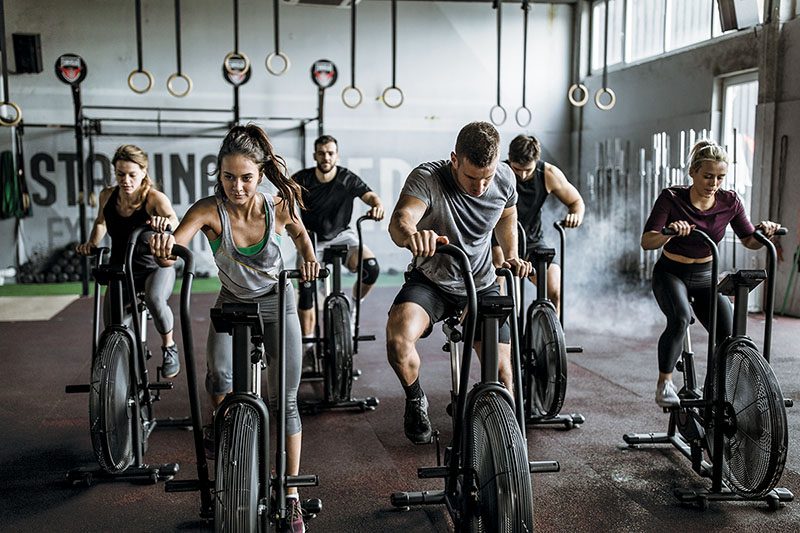Cycling is a great way to improve health and fitness with no impact on your bones and joints. Adjusting the time and intensity can accommodate anyone from beginners to elite athletes. Cycling can reduce your risk of stroke, heart disease, and diabetes and improve your mental health.
Regular bike training improves lower-body muscular strength, balance, and coordination. It is easy to fit into your daily life whether you rely on a stationary bike, commuter bike, group rides, or are training for a triathlon.
Safety considerations:
- Always wear a helmet.
- Make sure you are visible on roadways, and use lights at night.
- If possible, ride in cycling lanes, on neighborhood streets, or in a group.
Bike Options
A commuter bike is generally for short-distance transportation and may or may not have gears. Typically offering an upright, comfortable riding position, commuter bikes are built for paved roads, paths, and sidewalks.
A mountain bike has large, knobby tires that improve traction but require more effort to pedal. While still comfortable, the seated position is less upright than a commuter bike’s. Built for use on paved and unpaved paths, mountain bikes typically have gears to facilitate steep climbs and downhill rides.
Hybrid bikes are between road bikes and mountain bikes. The tires are wider than a road bike’s but narrower than a mountain bike’s. The riding position is less upright than on a mountain bike but more comfortable than on a road bike. Hybrid bikes typically have a few gears for uphill and downhill and can travel on unpaved roads but are not built for rugged terrain.
Built for speed, road bikes are fast and light. Their thin tires reduce resistance but do not do well on rough roads, potholes, or rocks. The riding position is more bent forward than the other bikes but not as low as a triathlon bike. Most group rides are on road bikes, so you may want to work toward being comfortable on a road bike if group riding with a local bike shop is your goal.
Triathlon bikes have aero bars that put the rider in a lower position than on a road bike. A triathlon bike is faster than a road bike but does not corner or climb steep slopes as well. Beginners training to complete their first triathlon can use any bike they are comfortable riding. Many triathlons have mountain bike or hybrid bike divisions for beginners.
Stationary bikes are great for bad weather days, spin classes, streaming classes, and varied-intensity rides. These bikes can be your sole mode of cycle training or supplement outdoor workouts.
Setup
For an ideal pedal stroke, you want a slight bend in your knee when seated on the bike with the pedal all the way down, but this may vary depending on your comfort with the bike and which type you use. If you aren’t sure about the setup, you can consult your local bike shop or any of the many online guides.
Technique
Try to keep your upper body relaxed with your head up and feet flat. Make sure that you sit on the widest part of your saddle (seat) and that your knees track straight forward as you pedal. They should not collapse inward or outward. If you are using clip-in pedals or cages, make sure that when one leg is pushing down (clock position 1 through 6), your other leg is pulling up (clock position 6 to 12).

Eight-Week Beginner Training Program
Beginners should target a mix of cycling durations with some cross-training and rest days. Short rides offer an opportunity to vary the intensity and fit your training into a busy schedule. Try to incorporate hills or speed (if outdoor) or increase resistance (if indoor) on short rides and maintain the increased intensity for 20 seconds every two minutes throughout your ride.
A starting point for mid-duration rides is increased intensity for 30 seconds every three to five minutes, depending on your comfort level. Longer rides should be at a speed and intensity that you can comfortably maintain throughout the ride.
Each week includes three cycling days, which you can complete in any order, and you can break up the cycling days with two cross-training days and two rest days.
Cross-training can consist of various exercises interspersed throughout your training program. Yoga is a great way to reduce injury risk while maintaining a healthy range of motion. Strength training increases bone density and muscle strength, and swimming or running can help improve aerobic capacity. The two rest days can consist of minimal activity such as walking or another form of light exercise, depending on your current fitness level.
Week 1
Short: 10-minute ride
Mid: 15-minute ride
Long: 20-minute ride
Week 2
Short: 15-minute ride
Mid: 20-minute ride
Long: 30-minute ride
Week 3
Short: 20-minute ride
Mid: 25-minute ride
Long: 30-minute ride
Week 4
Short: 20-minute ride
Mid: 30-minute ride
Long: 40-minute ride
Week 5
Short: 20-minute ride
Mid: 30-minute ride
Long: 45-minute ride
Week 6
Short: 20-minute ride
Mid: 35-minute ride
Long: 50-minute ride
Week 7
Short: 20-minute ride
Mid: 40-minute ride
Long: 55-minute ride
Week 8
Short: 20-minute ride
Mid: 45-minute ride
Long: 60-minute ride
© Alert Diver — Q1 2023